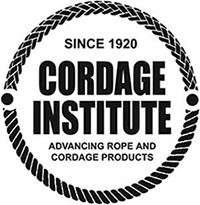Twisted Ropes
These ropes can be recognized by their spiral shapes. They are made by twisting together bundles of individual yarns to form strands, which are then twisted together to form the rope. Twisted ropes are easily spliced, but have inherent torque and therefore a tendency to kink up and rotate under load.
Braided Ropes
These ropes come in many variations and braiding patterns, but always consist of bundles of fiber which are formed into strands and then woven together by passing each strand over and under the others.
Cancord primarily manufactures braided ropes. Some of the different braided ropes we manufacture include:
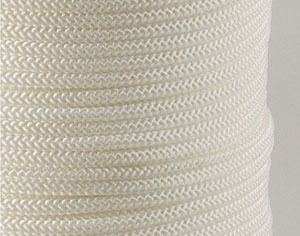 Diamond Braid: These ropes are formed by rotating half the yarn strands in one direction on the braider, while the other half rotate in the opposite direction. These cords may be hollow, or they may have a center core of parallel fibers. These ropes tend to be a little flatter than other braided rope constructions.
Diamond Braid: These ropes are formed by rotating half the yarn strands in one direction on the braider, while the other half rotate in the opposite direction. These cords may be hollow, or they may have a center core of parallel fibers. These ropes tend to be a little flatter than other braided rope constructions.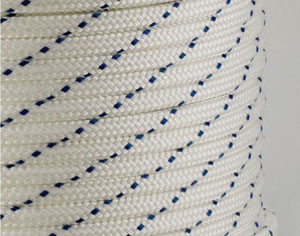 Double Braid: These ropes are constructed from an inner hollow single braided rope (core) which has another hollow single braided rope constructed around its exterior (skin). The end result is a rope within a rope. Both the skin and the core share the load on the rope, but not necessarily in equal amounts. These ropes are generally very flexible, strong and pleasant to handle. They are easily spliced. Caution must be exercised where double braid ropes are run over pulleys, through hardware, or in any situation where the outer rope may slide along on the inner rope and bunch up. This condition, often called “milking”, will result in a dramatic loss of strength by causing the entire load to be applied to the inner core. These ropes are also referred to as “Marine Ropes”, “Yacht Braid” and “2 in 1”.
Double Braid: These ropes are constructed from an inner hollow single braided rope (core) which has another hollow single braided rope constructed around its exterior (skin). The end result is a rope within a rope. Both the skin and the core share the load on the rope, but not necessarily in equal amounts. These ropes are generally very flexible, strong and pleasant to handle. They are easily spliced. Caution must be exercised where double braid ropes are run over pulleys, through hardware, or in any situation where the outer rope may slide along on the inner rope and bunch up. This condition, often called “milking”, will result in a dramatic loss of strength by causing the entire load to be applied to the inner core. These ropes are also referred to as “Marine Ropes”, “Yacht Braid” and “2 in 1”.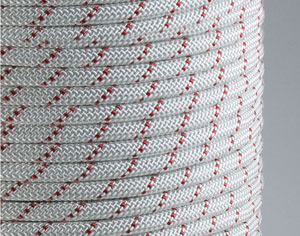 Kernmantle: These ropes are made by braiding a cover (mantle) over a core (kern). The core may consist of filaments of fiber lying essentially parallel inside the rope, or it may be twisted or braided into little bundles. The ropes are designed so that the inner core is taking most (often all) of the load, with the outer cover serving mainly to protect against abrasive action, dirt, and UV rays. All other types of rope have the load bearing fibers exposed and therefore deteriorate more rapidly. These ropes are exceptionally strong and durable, and can be made to have very low elongation. All kernmantle ropes have some stretch. However, static ropes are designed to minimize the amount of stretch, whereas dynamic ropes have relatively more stretch.
Kernmantle: These ropes are made by braiding a cover (mantle) over a core (kern). The core may consist of filaments of fiber lying essentially parallel inside the rope, or it may be twisted or braided into little bundles. The ropes are designed so that the inner core is taking most (often all) of the load, with the outer cover serving mainly to protect against abrasive action, dirt, and UV rays. All other types of rope have the load bearing fibers exposed and therefore deteriorate more rapidly. These ropes are exceptionally strong and durable, and can be made to have very low elongation. All kernmantle ropes have some stretch. However, static ropes are designed to minimize the amount of stretch, whereas dynamic ropes have relatively more stretch.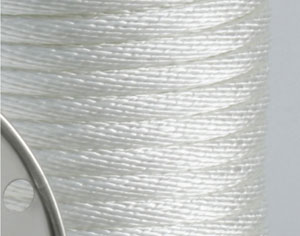 Solid Braid: These ropes are made by braiding 12, 18 or 20 strands in a reasonably complex pattern with all the strands rotating in the same direction on the braider. The center of the rope may contain a filler core. These ropes maintain their round shape and therefore work very well in pulleys and sheaves. They tend to have high elongation but generally have less strength than other constructions. They cannot be spliced. These ropes are also referred to as “Sash Braid”.
Solid Braid: These ropes are made by braiding 12, 18 or 20 strands in a reasonably complex pattern with all the strands rotating in the same direction on the braider. The center of the rope may contain a filler core. These ropes maintain their round shape and therefore work very well in pulleys and sheaves. They tend to have high elongation but generally have less strength than other constructions. They cannot be spliced. These ropes are also referred to as “Sash Braid”.

